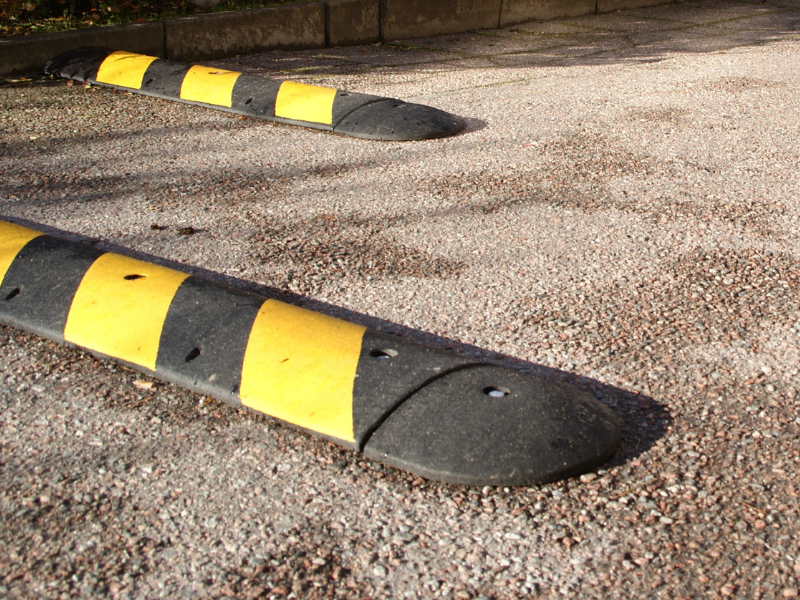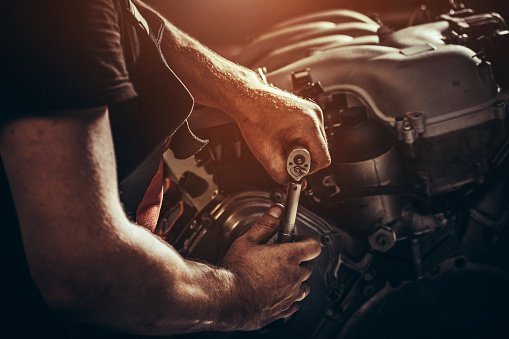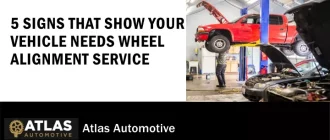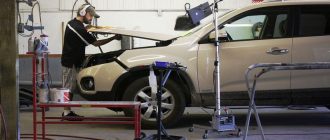
Signs Your Vehicle Needs Suspension Repair
If you notice any unusual sounds or experience a bumpy ride, it may be a sign that your vehicle needs suspension repair. The suspension system is responsible for ensuring a smooth and comfortable ride by absorbing shocks and vibrations on the road. Over time, components of the suspension system can wear out or become damaged, leading to decreased performance and potential safety hazards.
One of the key signs that your vehicle needs suspension repair is a noticeable change in ride quality. If you notice that your car is bouncing excessively or feels unstable, it may be time to have your suspension system inspected. Other symptoms can include uneven tire wear, a tendency to drift or pull to one side while driving, or difficulty steering. These issues can indicate problems with the suspension system, such as worn-out shocks or struts, damaged springs, or misaligned wheels.
It’s important not to ignore these signs, as a faulty suspension system can affect your vehicle’s handling and increase the likelihood of accidents. In addition to compromising your safety, driving with a worn-out suspension can also cause damage to other components of your vehicle, leading to more expensive repairs down the line. Regular maintenance and timely suspension repair can help to ensure that your vehicle stays in optimal condition and provides a safe and smooth ride for you and your passengers.
Unusual Noise from Suspension
If you notice any unusual noise coming from your vehicle’s suspension, it could be a sign that it needs repair. The suspension system of a vehicle is designed to provide a smooth and comfortable ride, and any noise can indicate a problem that needs to be addressed.
Common signs of suspension issues can include squeaking, creaking, knocking, or clunking sounds. These noises can occur when driving over bumps, turning corners, or even during normal driving conditions. It’s important to pay attention to any new or unusual noises and have them inspected by a professional mechanic.
One possible cause of unusual suspension noises is worn-out or damaged suspension components. Over time, the shock absorbers, struts, and other parts of the suspension system can become worn, leading to noise and decreased performance. Additionally, loose or damaged suspension mounts, bushings, and joints can also cause noise and should be checked.
| Squeaking | Worn-out bushings or mounts |
| Creaking | Dry or damaged suspension components |
| Knocking or clunking | Loose or damaged suspension components |
Ignoring unusual suspension noises can lead to further damage and potentially unsafe driving conditions. If you notice any of these signs, it’s important to have your suspension system inspected and repaired as soon as possible.
A professional mechanic can diagnose the cause of the noise and recommend the necessary repairs or replacements. By addressing suspension issues promptly, you can ensure a safe and smooth ride for your vehicle.
Rough and Bumpy Ride
One of the most obvious signs that your vehicle’s suspension needs repair is a rough and bumpy ride. If you notice that your vehicle is not providing a smooth and comfortable driving experience, it could be a clear indication that there is a problem with your suspension.
A healthy suspension system helps to absorb the shocks and bumps while driving, ensuring a stable and comfortable ride. However, when the suspension components are worn out or damaged, they won’t be able to perform their job properly. As a result, you will experience more vibrations, jolts, and bumps while driving.
It’s important to address this issue as soon as possible because ignoring it can lead to further damage to your vehicle and compromise your safety on the road. A rough and bumpy ride not only reduces driving comfort but also affects the vehicle’s handling and maneuverability.
If you are experiencing a rough and bumpy ride, it’s time to bring your vehicle to a trusted mechanic for a thorough inspection of the suspension system. They will be able to identify the underlying issue and provide the necessary repairs or replacements to restore your vehicle’s smooth and comfortable ride.
Remember: A rough and bumpy ride is one of the signs that your vehicle needs suspension repair. Don’t ignore it, as it can impact your driving experience and safety. Seek professional help to address the issue promptly.
Vehicle Pulls to One Side
If your vehicle consistently pulls to one side while driving, it is a clear sign that your suspension needs attention. This issue is most commonly caused by worn-out or damaged suspension components, such as springs, struts, or control arms. When these parts become worn or damaged, they can cause an imbalance in your vehicle’s weight distribution, leading to uneven steering and pulling to one side.
It is important not to ignore this problem, as it can affect your vehicle’s handling and safety. Pulling to one side can make it difficult to maintain control on the road, especially during turns or when braking. It can also cause uneven tire wear, reducing the lifespan of your tires and potentially leading to a blowout.
If you notice that your vehicle is pulling to one side, it is recommended to have your suspension inspected by a professional mechanic. They will be able to diagnose the underlying issue and recommend the appropriate suspension repairs or replacements. Taking care of suspension problems promptly can prevent further damage to your vehicle and ensure a smooth and safe driving experience.
Excessive Tire Wear
One of the signs that your vehicle may need suspension repair is excessive tire wear. If you notice that your tires are wearing down quickly or unevenly, it could be a sign that your suspension system is not properly absorbing the shocks and bumps of the road. When the suspension is not working correctly, it puts more stress on the tires, causing them to wear down faster.
There are a few different types of tire wear that can indicate suspension problems. Cupping or scalloping is when the tread on your tires becomes uneven, creating a pattern of dips and raised edges. This can be caused by worn out shocks or struts. Feathering is another type of tire wear that can occur when the tread on one side of the tire is smooth and the other side is sharp. This can be a sign of misalignment or worn suspension components.
If you notice any of these signs of excessive tire wear, it’s important to have your suspension system inspected and repaired as soon as possible. Driving with worn suspension components can not only lead to further tire damage, but it can also affect the handling and safety of your vehicle.
Signs of Fluid Leaks
If your vehicle needs suspension repair, it’s important to pay attention to signs of fluid leaks. Fluid leaks can indicate a problem with your suspension system and should be addressed promptly to prevent further damage and ensure your safety on the road.
Here are some signs of fluid leaks that may indicate suspension issues:
- Visible fluid underneath your vehicle – if you notice puddles or stains on the ground where you park your car, it could be a sign of a fluid leak. Suspension components like shocks and struts contain fluid, and a leak can cause this fluid to drip onto the ground.
- Low fluid levels – if you regularly check your fluid levels and notice that they are consistently low, it could be a sign of a leak. Check your owner’s manual for the proper procedure to check fluid levels.
- Unusual noises – if you hear strange noises such as squeaking, creaking, or knocking coming from your suspension, it could be a sign of a fluid leak. The lack of proper fluid can cause the suspension components to rub against each other, resulting in unusual sounds.
- Poor handling and steering – if you notice that your vehicle is pulling to one side, bouncing excessively, or experiencing a rough ride, it could be due to a suspension fluid leak. This can affect the stability and control of your vehicle, making it unsafe to drive.
- Uneven tire wear – if your tires are wearing unevenly, it could be a sign of suspension problems. A fluid leak can affect the alignment and balance of your vehicle, causing uneven wear on the tires.
If you notice any of these signs, it’s important to have your suspension system inspected and repaired by a qualified mechanic. Ignoring fluid leaks can lead to further damage and a potentially dangerous driving experience.
Uneven Ride Height
One of the signs that your vehicle needs suspension repair is an uneven ride height. When the suspension system is working properly, your vehicle should have an equal ride height on all four wheels. However, if you notice that one side of your vehicle is lower than the other, it could be a sign of suspension issues.
An uneven ride height can be caused by a variety of factors, including worn-out suspension components, a broken spring, or a leaking shock absorber. These issues can affect the overall stability and handling of your vehicle, making it more difficult to control.
If you experience an uneven ride height, it’s important to get your vehicle inspected and repaired by a professional mechanic. They will be able to diagnose the exact issue with your suspension system and recommend the necessary repairs.
| One side of the vehicle is lower than the other | Worn-out suspension components |
| The vehicle pulls to one side while driving | Broken spring |
| The ride feels bumpy and unstable | Leaking shock absorber |
It’s important to address uneven ride height issues as soon as possible to prevent further damage to your suspension system and ensure your vehicle’s safety and performance on the road.
Difficulty Steering
If you are experiencing difficulty steering your vehicle, it may be a sign that your suspension needs repair. When your suspension system is not functioning properly, it can affect the stability and control of your vehicle, making it harder to steer. This can put you and other drivers at risk on the road.
One of the common signs of suspension issues causing difficulty steering is a noticeable increase in the effort required to turn the steering wheel. You might find it harder to make small adjustments while driving, or the wheel may feel stiff and unresponsive.
In addition, you may also experience a pulling sensation while driving. If you notice that your vehicle tends to veer to one side, especially when you let go of the steering wheel, it can indicate a problem with your suspension. This can affect your ability to maintain your desired lane position and can be dangerous, especially at higher speeds or in heavy traffic.
It is important not to ignore these signs and symptoms, as a faulty suspension can lead to further damage and potential accidents. If you are experiencing difficulty steering or any other signs of suspension problems, it is recommended to seek professional repair services as soon as possible.
Remember that regular maintenance and inspections of your suspension system can help prevent issues and ensure the safety and performance of your vehicle on the road.
Decreased Braking Performance
A vehicle that needs suspension repair may exhibit decreased braking performance. This can be a sign that there is an issue with the suspension system, such as worn-out shocks or struts. When the suspension is not functioning properly, it can affect the vehicle’s ability to stop efficiently and safely.
If you notice that your vehicle takes longer to come to a complete stop or if you have to apply more pressure on the brake pedal to slow down, it is important to get your suspension system checked by a professional. Ignoring this sign can lead to further damage and potentially dangerous situations on the road.
In addition to decreased braking performance, other signs that your vehicle may need suspension repair include uneven tire wear, a bumpy or unstable ride, and excessive bouncing or dipping when going over bumps or dips in the road. It is important to pay attention to these symptoms and address them promptly to ensure your vehicle’s suspension is functioning properly.
Regular maintenance and inspection of your suspension system can help prevent these issues and ensure your vehicle is safe and performs optimally. If you experience any signs of suspension problems, it is recommended to consult with a qualified mechanic for a thorough inspection and necessary repairs.
Steering Wheel Vibration
One of the signs that your suspension needs repair is steering wheel vibration. If you notice a vibrating sensation through the steering wheel while driving, it could be an indication of suspension problems.
When your suspension is worn or damaged, it can cause the tires to become unbalanced, leading to vibrations that can be felt through the steering wheel. These vibrations may start off subtle but can become more pronounced as the suspension issues worsen.
Steering wheel vibration can also be caused by other factors, such as wheel misalignment or tire issues. However, if the vibration is accompanied by other suspension-related symptoms, such as a bumpy ride or uneven tire wear, it is more likely that your vehicle’s suspension needs repair.
If you experience steering wheel vibration, it is important to have your suspension system checked by a professional mechanic. They can inspect the components of your suspension, such as the shocks, struts, and control arms, to determine the cause of the vibration and make any necessary repairs. Taking care of suspension issues in a timely manner can help ensure a smooth and safe driving experience.
In conclusion, steering wheel vibration is one of the signs that your vehicle’s suspension needs repair. If you notice this symptom along with other suspension-related issues, it is important to have your suspension system checked by a professional mechanic to address any potential problems.
Fading or Dipping when Braking
If you notice that your vehicle tends to fade or dip when you apply the brakes, it could be a sign that your suspension is in need of repair. Fading or dipping occurs when the suspension is unable to properly support the weight of the vehicle during braking, causing it to tilt or dip forward.
This can be a dangerous situation, as it can impact the handling and control of your vehicle. It can also increase the stopping distance, making it more difficult to come to a complete stop in a timely manner.
If you experience fading or dipping when braking, it is important to have your suspension inspected and repaired as soon as possible. A professional mechanic will be able to diagnose the issue and determine the necessary repairs needed to restore the proper functionality of your suspension.
Some common causes of fading or dipping when braking include worn shocks or struts, weak or broken springs, or damaged suspension components. These issues can occur over time due to normal wear and tear, or they can be the result of a specific incident, such as hitting a pothole or curb.
Ignoring the signs that your suspension needs repair can lead to further damage and potentially increase the risk of an accident. It is important to address any issues with your suspension promptly to ensure the safety and performance of your vehicle.
If you notice any signs of fading or dipping when braking, it is recommended to have your suspension inspected by a professional mechanic. They will be able to assess the condition of your suspension system and perform any necessary repairs to ensure the proper functioning of your vehicle.
Suspension System Warning Light
If you notice the suspension system warning light illuminated on your vehicle’s dashboard, it is one of the signs that your vehicle needs suspension repair. This light indicates that there is a problem with your suspension system and it should not be ignored.
The suspension system warning light can mean different things depending on the make and model of your vehicle. However, some common issues that may trigger this warning light include:
- Low suspension fluid levels
- Failed suspension components
- Worn-out suspension springs
- Problems with the suspension control module
When the suspension system warning light is on, it is important to have your vehicle inspected by a professional mechanic as soon as possible. Ignoring this warning light and not taking the necessary suspension repair measures can lead to further damage to your vehicle’s suspension system and potentially affect its overall performance and safety.
Regularly checking your vehicle’s suspension system and addressing any issues promptly can help prevent more costly repairs and ensure a smooth and safe driving experience. If you notice the suspension system warning light or any other signs that your vehicle needs suspension repair, don’t hesitate to seek professional assistance for a thorough inspection and necessary repairs.
Suspension Feeling Loose
If your vehicle’s suspension feels loose, it could be a sign that it needs repair. A loose suspension can cause your vehicle to sway or feel unstable, especially when going over bumps or making turns. This can make your driving experience uncomfortable and potentially dangerous.
Common signs that your suspension may be feeling loose include:
- Excessive body roll when cornering
- Unusual noises, such as clunking or knocking sounds
- Uneven tire wear
- Difficulty maintaining control of your vehicle
- Uneven ride height
If you notice any of these signs, it’s important to have your suspension inspected and repaired as soon as possible. A professional mechanic can diagnose the issue with your suspension and recommend the necessary repairs to ensure your vehicle is safe and performs optimally.
Question-answer:
What are the signs that my vehicle needs suspension repair?
Some signs that your vehicle may need suspension repair include uneven tire wear, excessive bouncing or swaying, a harsh and bumpy ride, and a noticeable difference in handling and control.
How can I tell if my vehicle has a suspension problem?
If you notice any of the following symptoms, your vehicle may have a suspension problem: a bouncy ride, excessive body roll when turning, nose-diving when braking, uneven tire wear, or a drifting sensation while driving.
What causes suspension problems in vehicles?
Suspension problems can be caused by a variety of factors, including worn-out or damaged suspension components, a damaged or leaking shock absorber, misaligned wheels, or a broken spring.
Is it dangerous to drive with a suspension problem?
Driving with a suspension problem can be dangerous, as it can affect your vehicle’s stability, handling, and control. It is recommended to have your vehicle inspected and repaired by a professional if you suspect any suspension issues.
How much does suspension repair cost?
The cost of suspension repair can vary depending on the specific issue and the make and model of your vehicle. It is best to consult with a trusted mechanic or suspension specialist to get an accurate estimate for the repair.
What are some common signs that indicate a vehicle needs suspension repair?
Some common signs that indicate a vehicle needs suspension repair include: difficulty steering, uneven tire wear, excessive bouncing or dipping when driving over bumps, a drifting or pulling sensation when turning or changing lanes, a bumpy or uncomfortable ride, and leaking fluid from the shock absorbers.






